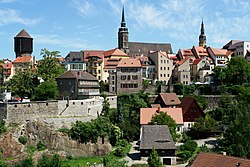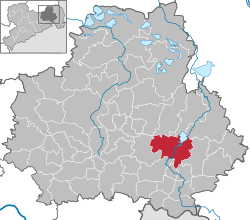Bautzen
| Bautzen/Budyšin | ||
|---|---|---|
 |
||
|
||
| Coordinates: 51°10′53″N 14°25′27″E / 51.18139°N 14.42417°ECoordinates: 51°10′53″N 14°25′27″E / 51.18139°N 14.42417°E | ||
| Country | Germany | |
| State | Saxony | |
| District | Bautzen | |
| Government | ||
| • Mayor | Alexander Ahrens (none) | |
| Area | ||
| • Total | 66.62 km2 (25.72 sq mi) | |
| Population (2015-12-31) | ||
| • Total | 39,845 | |
| • Density | 600/km2 (1,500/sq mi) | |
| Time zone | CET/CEST (UTC+1/+2) | |
| Postal codes | 02625 | |
| Dialling codes | 03591 | |
| Vehicle registration | BZ, BIW, HY, KM | |
| Website | www.bautzen.de | |
Bautzen (pronounced [ˈbaʊ̯t͡sən]; Upper Sorbian: Budyšin [ˈbudɨʃin]; Lower Sorbian: Budyšyn [ˈbudɨʃɨn], Czech: Budyšín [ˈbudɪʃiːn], Polish: Budziszyn [buˈd͡ʑiʂɨn]) is a hill-top town in eastern Saxony, Germany, and administrative centre of the eponymous district. It is located on the Spree River. As of 2013[update], its population is 39,607. Asteroid 11580 Bautzen is named in honour of the city.
Bautzen is often regarded as the unofficial, but historical capital of Upper Lusatia, and it is the most important cultural centre of the Sorbs, a Slavic people.
The town on the River Spree is situated about 50 km (31 mi) east of Dresden between the Lusatian highland and the lowlands in the north, amidst the region of Upper Lusatia. To the north stretches the Bautzen Reservoir, which was flooded in 1974. This is the former location of the villages of Malsitz (Małšecy) and Nimschütz (Hněwsecy).
...
Wikipedia



